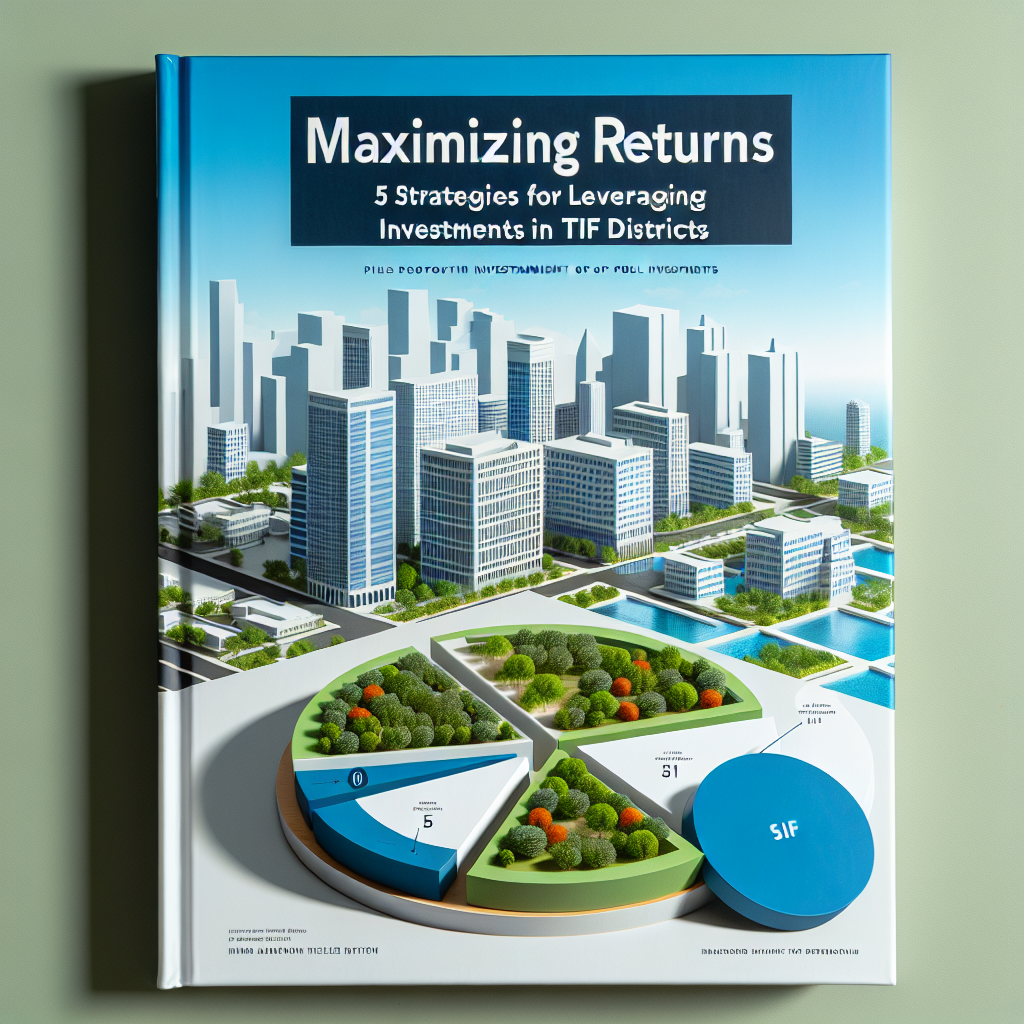-
Table of Contents
- Maximizing Returns: 5 Strategies for Leveraging Public Investments in TIF Districts
- 1. Comprehensive Planning and Stakeholder Engagement
- Engaging Stakeholders
- Data-Driven Planning
- 2. Strategic Infrastructure Investments
- Transportation and Accessibility
- Public Amenities and Green Spaces
- 3. Incentivizing Private Investment
- Financial Incentives
- Regulatory Flexibility
- 4. Monitoring and Evaluation
- Key Performance Indicators
- Adaptive Management
- 5. Promoting Equitable Development
- Affordable Housing
- Workforce Development
- Case Studies: Successful TIF Districts
- Denver Union Station TIF District
- Atlanta BeltLine TIF District
- Kansas City Power & Light District
- Conclusion
Maximizing Returns: 5 Strategies for Leveraging Public Investments in TIF Districts

Tax Increment Financing (TIF) districts have become a popular tool for municipalities to stimulate economic development and revitalize underperforming areas. By capturing the future tax benefits of increased property values, TIF districts can fund public infrastructure projects and incentivize private investment. However, maximizing returns from these public investments requires strategic planning and execution. This article explores five effective strategies for leveraging public investments in TIF districts to ensure sustainable growth and community benefits.
1. Comprehensive Planning and Stakeholder Engagement
One of the foundational strategies for maximizing returns in TIF districts is comprehensive planning and stakeholder engagement. A well-thought-out plan that aligns with the community’s needs and goals can significantly enhance the effectiveness of TIF investments.
Engaging Stakeholders
Engaging a broad range of stakeholders, including local residents, business owners, and community organizations, ensures that the TIF district’s development aligns with the community’s vision. This can be achieved through:
- Public meetings and workshops
- Surveys and feedback forms
- Advisory committees
For example, the City of Chicago’s North Branch Industrial Corridor TIF district involved extensive stakeholder engagement, resulting in a plan that balanced industrial growth with residential and recreational needs.
Data-Driven Planning
Utilizing data and analytics to inform planning decisions can help identify the most impactful projects. This includes analyzing:
- Current property values and tax revenues
- Demographic trends
- Economic indicators
By leveraging data, municipalities can prioritize projects that offer the highest potential returns and address critical community needs.
2. Strategic Infrastructure Investments
Investing in strategic infrastructure projects is crucial for attracting private investment and driving economic growth within TIF districts. These projects can range from transportation improvements to public amenities and utilities.
Transportation and Accessibility
Improving transportation infrastructure, such as roads, public transit, and pedestrian pathways, can enhance accessibility and attract businesses and residents to the area. For instance, the Denver Union Station TIF district invested heavily in transportation infrastructure, transforming the area into a bustling transit hub and spurring significant private development.
Public Amenities and Green Spaces
Creating public amenities and green spaces can improve the quality of life for residents and make the area more attractive to investors. Parks, recreational facilities, and cultural centers can serve as catalysts for development. The Atlanta BeltLine TIF district is a prime example, where investments in parks and trails have led to substantial private investment and increased property values.
3. Incentivizing Private Investment
To maximize returns, TIF districts should implement strategies that incentivize private investment. This can be achieved through various financial and regulatory incentives.
Financial Incentives
Offering financial incentives, such as grants, low-interest loans, and tax abatements, can encourage private developers to invest in the TIF district. These incentives can help offset the costs of development and reduce financial risks. For example, the Kansas City Power & Light District utilized TIF funds to provide financial incentives to developers, resulting in a vibrant mixed-use development that revitalized the downtown area.
Regulatory Flexibility
Providing regulatory flexibility, such as expedited permitting processes and relaxed zoning regulations, can also attract private investment. Streamlining the approval process can reduce development timelines and costs, making the TIF district more appealing to investors.
4. Monitoring and Evaluation
Continuous monitoring and evaluation of TIF district performance are essential for ensuring that public investments are yielding the desired returns. This involves tracking key performance indicators (KPIs) and making data-driven adjustments as needed.
Key Performance Indicators
Some important KPIs to monitor include:
- Property value increases
- Tax revenue growth
- Job creation
- Private investment levels
Regularly assessing these indicators can help identify areas where the TIF district is performing well and areas that may require additional attention or adjustments.
Adaptive Management
Adaptive management involves making data-driven adjustments to the TIF district’s strategies and projects based on performance evaluations. This approach ensures that the district remains responsive to changing conditions and continues to deliver maximum returns. For instance, the City of Portland’s River District TIF has successfully used adaptive management to adjust its strategies and maintain strong performance over time.
5. Promoting Equitable Development
Ensuring that the benefits of TIF district investments are equitably distributed is crucial for fostering community support and long-term sustainability. This involves implementing strategies that promote inclusive growth and address disparities.
Affordable Housing
Investing in affordable housing within TIF districts can help prevent displacement and ensure that low- and moderate-income residents benefit from the area’s development. For example, the City of San Francisco’s Mission Bay TIF district included a significant affordable housing component, providing homes for a diverse range of residents.
Workforce Development
Supporting workforce development initiatives, such as job training programs and educational opportunities, can help local residents access new employment opportunities created by TIF district investments. The City of Minneapolis’ North Loop TIF district has successfully implemented workforce development programs, resulting in increased employment rates and economic mobility for residents.
Case Studies: Successful TIF Districts
To illustrate the effectiveness of these strategies, let’s examine a few successful TIF districts that have maximized returns through strategic planning and investment.
Denver Union Station TIF District
The Denver Union Station TIF district is a prime example of how strategic infrastructure investments can drive economic growth. By investing in transportation infrastructure, including the renovation of Union Station and the development of a multimodal transit hub, the district attracted over $3 billion in private investment. The area has since transformed into a vibrant mixed-use community with residential, commercial, and retail spaces.
Atlanta BeltLine TIF District
The Atlanta BeltLine TIF district demonstrates the impact of investing in public amenities and green spaces. The BeltLine project, which includes parks, trails, and transit improvements, has spurred over $5 billion in private investment and significantly increased property values in the surrounding areas. The project has also created thousands of jobs and provided affordable housing options for residents.
Kansas City Power & Light District
The Kansas City Power & Light District showcases the effectiveness of financial incentives in attracting private investment. By offering grants and tax abatements to developers, the district successfully revitalized a previously underperforming area into a thriving entertainment and business hub. The project has generated substantial tax revenue and created numerous job opportunities for local residents.
Conclusion
Maximizing returns from public investments in TIF districts requires a multifaceted approach that includes comprehensive planning, strategic infrastructure investments, incentivizing private investment, continuous monitoring and evaluation, and promoting equitable development. By implementing these strategies, municipalities can ensure that TIF districts deliver sustainable economic growth and community benefits.
Successful examples, such as the Denver Union Station, Atlanta BeltLine, and Kansas City Power & Light districts, demonstrate the potential of TIF districts to transform underperforming areas into vibrant, thriving communities. By learning from these case studies and adopting best practices, municipalities can leverage TIF districts to achieve their economic development goals and create lasting positive impacts for their residents.








